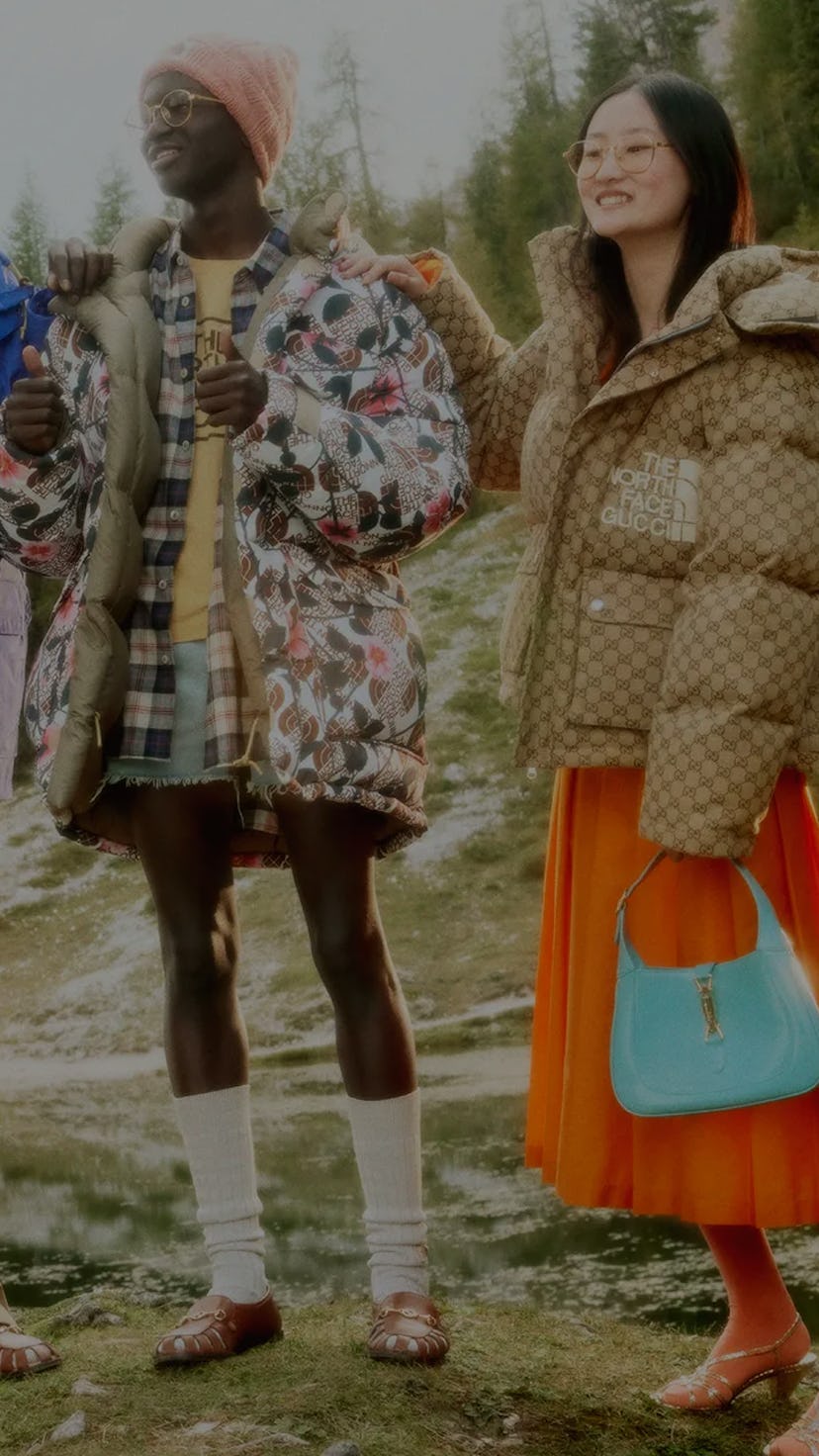The Great Outdoors
What is the point of luxury outdoor gear?
The luxury outdoor gear trend is a surface-level analysis of what the rich think spending time outside looks like.

The luxury world’s flirtation with outdoor gear has become a full-on affair.
Since Gucci partnered with The North Face in 2019 — creating designer puffer coats, hiking backpacks, and even logo-filled tents — high-fashion brands including Loewe, Balenciaga, and Prada have followed suit in producing three and four-figure outdoor gear. Pieces originally meant for exploring, such as Arc'teryx jackets and Salomon hiking sneakers, are now braving Brooklyn neighborhoods as much as they are the great outdoors.
Post-quarantine, practical styles have become favored in spite of their impractical price tags. As wellness and comfort take priority in fashion, luxury shoppers seem to be discovering pieces outdoor enthusiasts have been well-acquainted with for decades, albeit with ridiculous price tags and designer logos now attached. There’s a sense of irony in paying $3,400 for a down puffer or $1,000 for a hiking sandal considering you need not afford either to access the outdoors. In fact, bonafide outdoor brands including The North Face and Patagonia have worked to make outdoor activities more accessible.
Those indulging in more expensive outdoor gear are more likely to glamp on the Amalfi Coast, lounge at five-star resorts or — as celebrities like Frank Ocean, Bella Hadid, and Drake have demonstrated — not wear the outdoor pieces in the outdoors at all. Instead, designer outdoor wear lends its look of utility and normalcy to those that are anything but. The pieces say, I’m just like you, while luxury logos add, except I’m not.
The great faux-doors
When outdoor gear started to trend in 2017 — dubbed “gorpcore” by The Cut — its function was still a selling point. People with no previous outdoor experience, especially urban consumers, realized the practicality of gorp: Hiking shoes doubled as comfortable deli run sneakers; lined rain jackets made for great splash protection at intersections; and cargo pants offered a way to keep your belongings close. Shoppers wanted pieces that worked for their lifestyles, regardless of their intended use.
Of course, the sleek and tech-heavy look of outdoor wear only enhanced its popularity. By 2020, gorp had been adopted by streetwear brands including Brain Dead and Stüssy, while traditional outdoor labels started to embrace their new consumers through collaborations. Function was still a primary focus for shoppers, but bold patterns and celebrity endorsement emphasized the look of outdoor gear.
Luxury logos fully transitioned the pieces from gorp to grail. Experts in the outdoor field such as Patagonia or Nike All Conditions Gear have been dismissed by some in favor of flashy branding from Gucci, Prada, or Dior. The emblazoned pieces still flaunt practical aspects, but their purpose (and price tag) lean more into appearances than action. Why would a real outdoor enthusiast want a Gucci x The North Face puffer when the same TNF jacket was available for a tenth of the price sans logos?
Go (spend) green
For those privileged enough to partake in the trend, outdoor wear is an aesthetic and nothing more. Who wants to get down and dirty in a Prada fishing vest if it can only be dry-cleaned? Why bother camping in a regular tent when you could take Instagram photos outside one decorated in Gucci logos?
Without such extravagant branding, outdoor gear should be about the experience people have while wearing it. There’s a reason Canada Goose offers in-store freezer rooms for customers to test jackets and Moncler field tests its jackets with famous explorers like Michele Pontrandolfo. Luxury gorp pieces simply offer a frillier experience — one more fit for those who use “summer” as a verb and not a noun.
At its core, outdoor gear is more about being green than spending green. Pieces are meant to withstand both weather and time; they’re not a trend to rotate out for something new after a few weeks. And as studies show, the average outdoor enthusiast is interested in sustainability: Some people wear their gear into the ground, while others avoid companies that don’t follow eco-friendly practices.
For outdoor-focused brands, the sustainable efforts are matched by company and customer alike. Patagonia famously operates like an environmental advocacy group, calling out overconsumption on Black Friday and stripping its vests of corporate logos that don’t align with its eco-conscious message. Through its Renewed program, The North Face repairs and refurbishes used or damaged garments so they can be used again. But for designer labels that tout technical apparel, sustainability is lacking.
There’s nothing about luxury outdoor gear that actually celebrates the outdoors.
While Prada Outdoor’s Mountain collection uses recycled materials, many of its products are made of nitrous-oxide producing nylon, which is challenging to reuse sustainably. Polyester pieces make up more than half of Gucci’s collection with The North Face, offering durable waterproofing but significant negative environmental impact during production, use, and disposal. Even Balenciaga’s retro rain jackets utilize hazardous chemicals like water-resistant PFCs, polyfluorinated chemicals found everywhere from our rivers to the livers of polar bears.
There’s nothing about luxury outdoor gear that actually celebrates the outdoors. Like most designer products, it’s more about a perceived idea, a surface-level analysis of what the rich think spending time outside looks like. And while the one percent continues to explore the faux-doors, the rest of us will actually be on the outside, looking in.